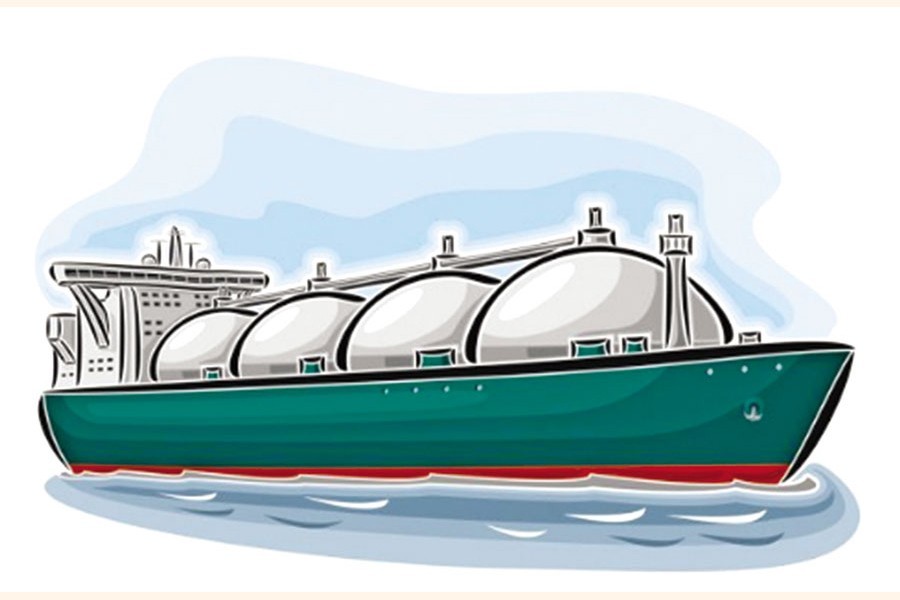Bangladesh's liquefied natural gas (LNG) demand over the next two to three years is unlikely to rise significantly beyond the pre-Ukraine crisis level - due to depleting foreign-currency reserves and devaluation of the local currency.
Instead, the government is expected to maintain coal-fired power generation to minimise power shortage, Institute for Energy Economics and Financial Analysis (IEEFA), a US-based global think-tank, reported in its upcoming Global LNG Outlook 2023-27 on Wednesday.
Bangladesh government has also set an ambitious target of using 40 per cent renewable energy by 2041 as part of the draft Mujib Climate Prosperity Plan.
Given that power, industry, and captive generation sectors are responsible for more than 70 per cent of the country's total annual gas consumption, the success of this plan could reduce LNG demand growth here, the IEEFA outlook maintained.
Bangladesh met 21 per cent of its gas demand through imported LNG during fiscal year (FY) 2020-21.
Roughly 20 per cent of the country's total LNG import came from the spot market, at an average price of US$7.98 per million British thermal unit (MMBtu), it noted.
In July 2022, however, the government ceased spot market purchase due to high price.
Meanwhile, suppliers under Bangladesh's two long-term LNG contracts - Qatar Gas and Oman Trading International - exercised downward quantity tolerance to limit contracted volume delivery. As a result, the country's LNG import contracted by 16 per cent in 2022.
The IEEFA also pointed out that the Russian invasion of Ukraine upended global LNG market last year - spurring Europe to buy record quantity of the fuel, and pushing its price to the highest level ever.
In Asia, LNG is considered an expensive and unreliable fuel source, clouding its future demand.
The EU is taking aggressive steps to trim gas consumption, which could render new LNG import capacity unneeded.
Although the global LNG market may remain tight for several years, it will see a wave of new projects coming online in 2025-27 -potentially leading to a supply-demand mismatch and financial risks for LNG suppliers and traders.
Global LNG supply is likely to remain tight throughout 2025, curbing demand growth in the key Asian import markets, the IEEFA predicted.
European LNG demand may remain strong in the short term, but will decline by 2030, as decarbonisation and energy security policies take effect.
Meanwhile, a wave of new LNG export capacity - coming online later in the decade - could create a mismatch between supply and demand, elevating financial risks for LNG suppliers and traders.
The IEEFA report found that last year's LNG market turmoil -characterised by record high prices and unreliable supplies - undermined long-term LNG demand growth in both Europe and Asia.
In 2022, the European countries boosted LNG import by 60 per cent to make up for declining pipeline gas shipment from Russia. Europe's red-hot LNG demand drove global spot prices to all-time high, forcing price-sensitive Asian buyers to slash LNG purchase and curtail plans for new LNG import.
China cut LNG purchase by 20 per cent in 2022 due to a combination of high price, COVID-19 shutdown, and slower economic growth.
High LNG price pushed the country's gas buyers to rely more heavily on domestic production and pipeline import.
Like Bangladesh, India and Pakistan also slashed LNG demand by 16 per cent last year.
Concerns over fuel security, unaffordability, rapidly depleting foreign currency reserve, and demand destruction could limit the region's medium-term LNG import.
The Southeast Asian buyers face challenges like high prices and infrastructure constraints. Long-term LNG contracts with deliveries starting before 2026 are reportedly sold out globally, forcing the Southeast Asian countries to step into expensive spot market.
In Japan and South Korea, high LNG price accelerated a resurgence of nuclear power generation that could slash power sector gas demand.
Europe's LNG demand could remain strong in 2023, but it is poised to fall, as the EU climate and energy security policies curtail gas demand by at least 40 per cent through 2030.
Although new LNG terminals could boost the continent's import capacity by one-third by the end of 2024, Europe's ambitious energy transition targets mean that much of the new capacity could remain unused, the IEEFA outcome noted.
When a large volume of new supply will enter the market starting in mid-2025, it could trigger a supply glut, heightening the financial and pricing risks for LNG exporters and traders, it added.


